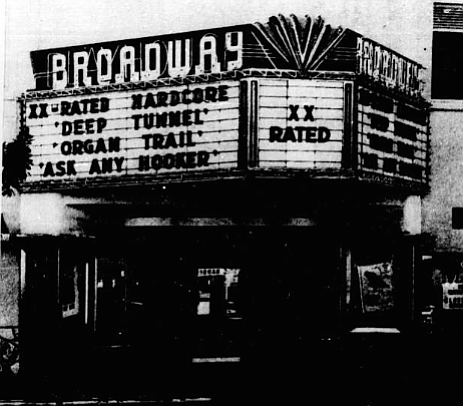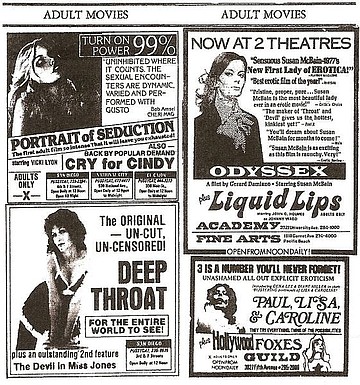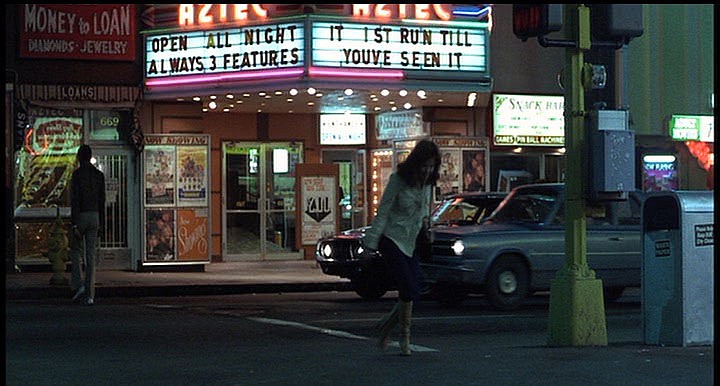 Facebook
Facebook
 X
X
 Instagram
Instagram
 TikTok
TikTok
 Youtube
Youtube

One of the puzzles of the movie scene, here and everywhere, is the enduring prosperity and, more, the proliferation of the "hard,” “strong,” "triple-X" movies that are never mentioned by name in the S.D. Union-Tribune and are confined en masse, quarantine style, on one page in the L.A. Times. It is now years after these movies have successfully nose-thumbed the last taboo (what was referred to by avant-garde zealots in the girlie-movie business as “going all the way”).

And there still isn't a discernible decline in the number of penny arcades, book stores, car rooms, laundromats that convert to mini- theaters, so-called, to showcase the "hard" stuff, nor in the number of long-standing movie houses that fall to the same temptation. (Locally the Capri Broadway, Tower, Fine Arts, Academy, Guild — which group includes some of the theaters with, formerly, the most creative programming in San Diego.) I don't imagine I can explain it, and am not to try, except to explain why it's a puzzle to me, too.
The class of movie I'm thinking of, not to be confused with the class that is called "soft-core,” "simulated,” and "sissy stuff,” has basically the instincts of a dog. It goes straight for the crotch. With an unblinking patience almost unknown outside of structural cinema (Warhol's eight-hour long-shot of the Empire State Building ) or cinema verite (Shirley Clarke’s listen to the rambling, point blank confessions of a black homosexual), it records the motion described picturesquely in Anthony Burgess's futureworld as the "in-out.” A motion as monotonous, methodical mechanical, but scarcely as beautiful, as a piston’s. Once past the point of penetration, and probably long before that, the course of events is completely predictable and the spectator is left to measure the duration by the number of minutes, the number of "in-outs,” or the number of SweetTarts he can consume. And past that point. I'm inclined to think, the interest of the scene, if any, it strictly between the He and She on screen.
The excitement of watching this spectacle, it is commonly supposed, is the excitement of a voyeur. And maybe it is, partially. But if it it voyeurism, it if voyeurism minus the covertness. and minus the risk, and minus the ingenuity. It is possibly more like witnessing a case of exhibitionism — minus the surprise. Either way, the spectator's detachment from the on-screen spectacle frees him from complicity. (When vice squads were still actively on alert — on their marks, get set, go — in defense of public morals at large, it was of course the film they seized in such cases.) And either way, the spectator's paying for the privilege of witnessing this stuff makes it seem less clandestine. The actors, or athletes if you'd rather, have agreed to perform; they have not been "caught" at it. There is, plot or no plot, practically no fictional illusion in these movies; they deal in the real thing.
There is for sure, little about the typical image in these movies to create any illusion. The intention is to "show all,” including, if necessary, knee bruises and appendectomy scars and whatever; and the result is a harsh, scalding, shadowless, all-over lighting effect, like over an operating table. Under these conditions, the human skin — by far the dominant color — looks about as healthy at if it had been stripped from the bodies, stretched, pounded, dried, and used for lamp shades. Myself, I have to look away from this sort of thing on screen sooner than I look away from hatchet murders and machine gunnings.
These movies are almost always made cheaply, and almost always incompetently: and the encouraging blurbs reprinted in the advertisements (“the Rolls Royce of porn" for Behind the Green Door) must be understood relatively. They know next to nothing of the seducer's wiles — the prurient effect of the proper light and shadow, color, upholstery, camera angle, whatnot — that were practiced, for instance, by Vadim, Pecas, and others, in the early-'60s flow of dubbed French imports, before they were finally chased out of Adults Only theaters by the hardcore article.
Pornographic movies, these days, tend to underrate how much the erotic effect depends on a mental state — a subjective point of view. Instead, they are content to offer just the physical aspect (and that, generally, from a fixed, gynecologist's vantage point), and the variations on that level are severely limited — variations in the number of bodies, the amount of eye-rolling and lip-hacking inserted in the action, and the additional props (molasses, snakes, finger-paints, what-have-you). With all their limitations, the Vadim-Pecas romanticists at least suffused their movies with an aura of private fantasy that could pass as a credible notion of eroticism. The porn-movies today are in general so aggressively anti-erotic, vacuous, and monotonous that they can serve better as wide-open playgrounds for radical film theorists and discussions of Art Brut pictorialism, antinarrative structure, the spontaneous conventions of an incipient film genre, and so on. And anyone in search of a bit of below-the-belt stimulation could hardly do worse if he stuck to his own daydreams.

Changing the subject. The Aztec theater, one of the all-night triple-feature grindmills down-town, bears the following pronouncement on its marquee: "IT'S FIRST RUN TILL YOU'VE SEEN IT." This week at least, the hint of defensiveness contained there may be dispensed with completely. Through Saturday, the Aztec is showing Francesco Rosi's Lucky Luciano, which has not until now played in San Diego, and which to my knowledge hasn't played in Los Angeles either, and which has caused me to drum the desk impatiently for more than a year.


One of the puzzles of the movie scene, here and everywhere, is the enduring prosperity and, more, the proliferation of the "hard,” “strong,” "triple-X" movies that are never mentioned by name in the S.D. Union-Tribune and are confined en masse, quarantine style, on one page in the L.A. Times. It is now years after these movies have successfully nose-thumbed the last taboo (what was referred to by avant-garde zealots in the girlie-movie business as “going all the way”).

And there still isn't a discernible decline in the number of penny arcades, book stores, car rooms, laundromats that convert to mini- theaters, so-called, to showcase the "hard" stuff, nor in the number of long-standing movie houses that fall to the same temptation. (Locally the Capri Broadway, Tower, Fine Arts, Academy, Guild — which group includes some of the theaters with, formerly, the most creative programming in San Diego.) I don't imagine I can explain it, and am not to try, except to explain why it's a puzzle to me, too.
The class of movie I'm thinking of, not to be confused with the class that is called "soft-core,” "simulated,” and "sissy stuff,” has basically the instincts of a dog. It goes straight for the crotch. With an unblinking patience almost unknown outside of structural cinema (Warhol's eight-hour long-shot of the Empire State Building ) or cinema verite (Shirley Clarke’s listen to the rambling, point blank confessions of a black homosexual), it records the motion described picturesquely in Anthony Burgess's futureworld as the "in-out.” A motion as monotonous, methodical mechanical, but scarcely as beautiful, as a piston’s. Once past the point of penetration, and probably long before that, the course of events is completely predictable and the spectator is left to measure the duration by the number of minutes, the number of "in-outs,” or the number of SweetTarts he can consume. And past that point. I'm inclined to think, the interest of the scene, if any, it strictly between the He and She on screen.
The excitement of watching this spectacle, it is commonly supposed, is the excitement of a voyeur. And maybe it is, partially. But if it it voyeurism, it if voyeurism minus the covertness. and minus the risk, and minus the ingenuity. It is possibly more like witnessing a case of exhibitionism — minus the surprise. Either way, the spectator's detachment from the on-screen spectacle frees him from complicity. (When vice squads were still actively on alert — on their marks, get set, go — in defense of public morals at large, it was of course the film they seized in such cases.) And either way, the spectator's paying for the privilege of witnessing this stuff makes it seem less clandestine. The actors, or athletes if you'd rather, have agreed to perform; they have not been "caught" at it. There is, plot or no plot, practically no fictional illusion in these movies; they deal in the real thing.
There is for sure, little about the typical image in these movies to create any illusion. The intention is to "show all,” including, if necessary, knee bruises and appendectomy scars and whatever; and the result is a harsh, scalding, shadowless, all-over lighting effect, like over an operating table. Under these conditions, the human skin — by far the dominant color — looks about as healthy at if it had been stripped from the bodies, stretched, pounded, dried, and used for lamp shades. Myself, I have to look away from this sort of thing on screen sooner than I look away from hatchet murders and machine gunnings.
These movies are almost always made cheaply, and almost always incompetently: and the encouraging blurbs reprinted in the advertisements (“the Rolls Royce of porn" for Behind the Green Door) must be understood relatively. They know next to nothing of the seducer's wiles — the prurient effect of the proper light and shadow, color, upholstery, camera angle, whatnot — that were practiced, for instance, by Vadim, Pecas, and others, in the early-'60s flow of dubbed French imports, before they were finally chased out of Adults Only theaters by the hardcore article.
Pornographic movies, these days, tend to underrate how much the erotic effect depends on a mental state — a subjective point of view. Instead, they are content to offer just the physical aspect (and that, generally, from a fixed, gynecologist's vantage point), and the variations on that level are severely limited — variations in the number of bodies, the amount of eye-rolling and lip-hacking inserted in the action, and the additional props (molasses, snakes, finger-paints, what-have-you). With all their limitations, the Vadim-Pecas romanticists at least suffused their movies with an aura of private fantasy that could pass as a credible notion of eroticism. The porn-movies today are in general so aggressively anti-erotic, vacuous, and monotonous that they can serve better as wide-open playgrounds for radical film theorists and discussions of Art Brut pictorialism, antinarrative structure, the spontaneous conventions of an incipient film genre, and so on. And anyone in search of a bit of below-the-belt stimulation could hardly do worse if he stuck to his own daydreams.

Changing the subject. The Aztec theater, one of the all-night triple-feature grindmills down-town, bears the following pronouncement on its marquee: "IT'S FIRST RUN TILL YOU'VE SEEN IT." This week at least, the hint of defensiveness contained there may be dispensed with completely. Through Saturday, the Aztec is showing Francesco Rosi's Lucky Luciano, which has not until now played in San Diego, and which to my knowledge hasn't played in Los Angeles either, and which has caused me to drum the desk impatiently for more than a year.
Comments